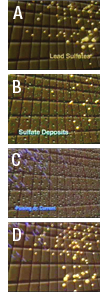A LEAD ACID BATTERY DESULFATION TUTORIAL
While there are many battery chemistries today, and new types becoming commercially viable over time, we deal with the lead acid types, flooded, AGM, and true Gel, as they are widely used in the applications we specialize in. A typical lead acid battery cell has two plate types, one of lead and one of lead dioxide, both in contact with the sulfuric acid electrolyte as either a liquid, absorbed in a mat (AGM), or a gel. The lead dioxide (PbO2) plate reacts with the sulfuric acid (H2SO4) electrolyte resulting in hydrogen ions and oxygen ions (which make water) and lead sulfate (PbSO4) on the plate. The lead plate reacts with the electrolyte (sulfuric acid) and leaves lead sulfate (PbSO4), and a free electron. Discharge of the battery (allowing electrons to leave the battery) results in the build up of lead sulfate on the plates and water dilution of the acid. The specific gravity of the electrolyte as measured with a hydrometer in flooded batteries, indicates its relative charge (strength), or level of dilution (discharge). The reversibility of this reaction gives us the usefulness of a lead acid battery.
Charging the battery is reversing the process above, and involves subjecting the battery to voltages higher than its existing voltage. The higher the voltage, the faster the charge rate, subject to some limitations. There is a gassing point to consider, and true gel batteries have a lower peak charge voltage, because bubbles can occur in the gel which don't dissipate, and result in battery damage. More on this in the charging tutorial. The lead sulfate crystals are broken down (more or less successfully) in the charge cycle. Sometimes some crystals remain, or sometimes a battery is left partially discharged where the crystals of lead sulfate harden, and reduce the capacity of the battery to be charged. This is what desulfation (desulphation)is about.
Internal discharge
Batteries are subject to an internal discharge, also called self-discharge. This rate is determined by the battery type, and the metallurgy of the lead used in its construction. Wet cells, with the cavities inside for electrolyte, use a lead-antimony alloy to increase mechanical strength. The antimony also increases the internal discharge rate to between 8% and 40% per month. For this reason, wet cells should not be left unmaintained or uncharged for long periods. The lead used in Gel and AGM battery construction does not require high mechanical strength since it is stabilized by the gel or mat material. Usually calcium is alloyed with the lead to reduce gassing and the internal discharge rate, which is only 2% to 10% per month for the AGM and Gel batteries.
Any battery discharge, including internal discharge, produces sulphation on the battery plates as part of the chemical cycle, and given enough time, this sulphation hardens, causing diminished battery capacity at best, or total loss of function. Routine charging after use, or use of a "floating" charger for long periods of storage (boat batteries, ATVs, etc.) reduces this diminished capacity and maximizes battery life. A large portion (approaching 50%) of lead acid batteries have diminished capacity or become unusable due to sulphation, and never reach their rated lifespan.
PulseTech Desulfation Technology
Lab and field tests by individuals, companies and government agencies around the world have proven that Pulse Technology works. It is literally the most effective method available for ensuring lead-acid battery performance, increasing battery efficiency and reducing battery-related costs. In 1995, PulseTech™ applied their technology to a full line of innovative and unique products designed to make batteries stronger so they will work harder and last longer than ever before. Today, they offer over 60 products designed to help you reduce battery-related problems and costs. While we don’t carry all 60 products in stock, we have access to them.
To get an idea of exactly how important pulse technology is to the performance of all your vehicles, consider this: The main cause of vehicle failure is battery failure due to sulfation buildup on the battery plates. And Pulse Technology prevents sulfation buildup. In most cases, your battery is still good. You just can't reach the energy inside. That means you have to buy another battery even though the one you have may still be usable. PulseTech products help prevent this problem.
How PulseTech™ Products Make Batteries Stronger
PulseTech products connect directly to the battery. They emit a pulsating dc current that removes the sulfate deposits from the plates and returns them to the battery acid as active electrolyte. When installed permanently, these products also help keep sulfates from building up again so your battery is in peak condition all the time. In most cases, some of these products even help renew dead batteries already suffering from sulfation buildup and help bring them back to life.

Here's how it works :
Figure A: Lead-acid batteries work by releasing energy through an interaction that occurs
between the positive and negative lead plates and the lead sulfates in the electrolyte.
Figure B: Sulfation buildup occurs as lead sulfates form on the battery plates during the
normal charge/discharge cycles. During this process, some of the sulfates enlarge to the
point where they won't accept energy so they stay on the plate. Over time, these sulfates
can build up until they reduce efficiency and the battery dies.
Figure C: Pulse Technology works to prevent sulfation buildup by removing the sulfate
deposits from the plates through a unique Ion Transfer process. The lead sulfates
then return to the battery acid as active electrolyte. When connected on a regular
basis, our battery maintenance systems will also keep the sulfates from building up again.
Figure D: Clean plates help the battery will perform at peak efficiency and battery life
extends dramatically. Charge acceptance is greater so the battery recharges faster and with
better quality. That means the battery charges to full capacity so more energy is available
to your vehicle.
Get TRUE Battery Power
Pulse Technology works with all types of lead-acid batteries including sealed, gel cell and AGM. By keeping the plates clean, a battery charges faster and deeper so it works harder and lasts longer than you ever thought possible. It also has greater charge acceptance to recharge faster and release all of its stored energy. With more available energy, your vehicles last longer between recharges and your electronic accessories work better. You get the true power of your batteries. Some of these patented products also prevent the normal loss of battery power on stored vehicles and equipment, no matter how long they sit unused -- even months at a time.
These systems even help protect the environment. Longer lasting batteries reduce the danger of contamination caused by lead and sulfuric acid dumped from prematurely discarded batteries.
Unique Technology
What makes Pulse Technology so unique and so effective is the distinct pulse waveform that defines it. This waveform has a strictly controlled rise time, pulse width, frequency and amplitude of current and voltage pulse. No other battery maintenance system in the world has this specific waveform, which means no other system can provide the same exceptional benefits as PulseTech products. PulseTech supplies many of these products to the U.S. military, and has for some time. We have used the patented pulse technology (as opposed to some charging companies that promote a generic ‘pulse’ stage) for years, and when properly selected and applied, it does what they say it will. So check out our selection, or call with specific applications.








